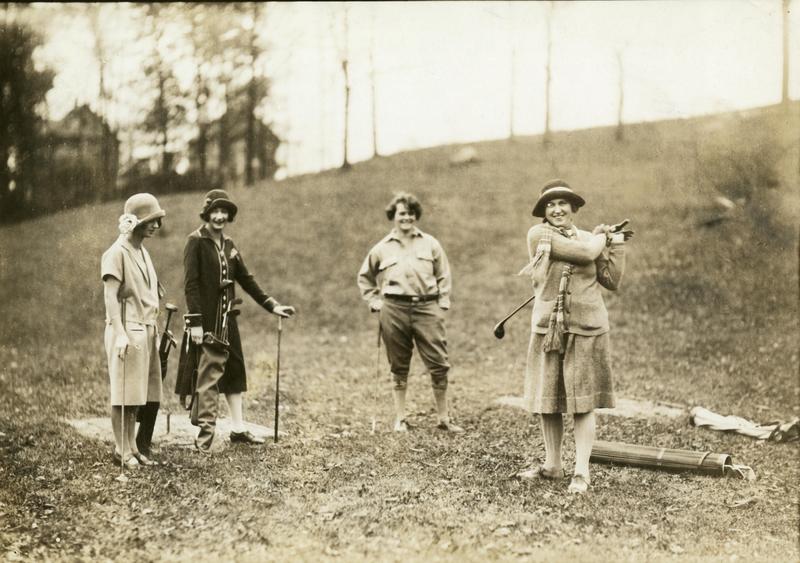Title IX
During the heyday of the Women’s Athletic Association in the 1930s and 1940s, as many as two-thirds of the female undergraduates were involved in athletics in some form.1 This enthusiasm waned in the 1960s once the organization of student housing changed, as more women students started to live off-campus thereby decentralizing women’s social life. The social movements of the 1960s and 1970s gave groups that were previously not given much of a voice a chance to assert their rights and struggle for equality. In schools, attention was given to equality of the sexes and efforts were made to provide equal opportunity and funding for both men and women. Such a social climate gave birth to Title IX, a federal mandate that prohibited discrimination on the basis of sex for any federally-funded program.
One of the main concerns arising from Title IX was athletics. Since Michigan was home to one of the most prestigious athletic programs in the country, a contentious debate over the funding of women’s athletics was inevitable. Since the Women’s Athletic Association was founded in 1893, women had athletic opportunities but not at an intercollegiate level. When intercollegiate athletics began at Michigan, funds were devoted to revenue-making men’s programs and an overly competitive women’s athletic program was believed to be detrimental to student well-being. However, the social climate of the 1960s and 1970s saw a change in this belief as women began to gain more athletic recognition.
Beginning in 1970, the Department of Physical Education included both men’s and women’s athletic programs, leading the way for the current athletic system at Michigan. However, women’s athletics were still at the club and intramural level; less money was allocated to these programs, giving women fewer opportunities to compete at the same level as men. Under Eunice Burns, chair of the U-M Commission for Women during President Robben Fleming's administration, the Burns Committee was established in 1973. The Committe set out to make recommendations to the school administration for intercollegiate women’s athletics. The Committee advised many changes including in coaching, organizational framework, and financing, in addition to suggesting six women’s sports to consider making varsity: basketball, field hockey, swimming and diving, synchronized swimming, tennis, and volleyball.2
Though Title IX was passed in 1972, it took three more years for the law to have specific guidelines for enforcement. Under President Gerald Ford, a Michigan alumnus, these guidelines were set despite vociferous opposition from Athletic Director Don Canham and men’s football coach Bo Schembechler. Canham and Schembechler agreed that women should be given equal opportunities for athletic education, but objected on the grounds that men’s programs would lose funding given a clause for proportionate funding. Jane Myers, a women’s athletic administrator, sent an open letter to Canham advocating for Title IX compliance, stating sardonically:
"YEAH, I KNOW, the men make money and the women don’t. But don’t you ever feel the slightest twinge of guilt, Don, when you think that women can get a closeup on the ABC-TV cameras on your football field only if she puts on a short skirt and waves a bunch of silly snips of paper?
"I’ll bet you could get female football players before the ABC cameras if you wanted to. All you’d have to say is “OK, ABC, you can have my boys, but you’ll have to hang around for the girls’ game that follows.” They’d hang around, Don, and you know it."3
Myers also lambasted Canham for wanting to set up the Michigan Football team as a nonprofit in order to be exempt from Title IX mandates, since the football program did not receive federal funding and Title IX only applied to federally-funded programs.
Eventually, the federal Department of Health, Education, and Welfare issued a three-pronged test requiring institutions to follow at least one of the three main criteria:
- The number of male and female athletes is substantially proportionate to their respective enrollments; or
- The institution has a history and continuing practice of expanding participation opportunities responsive to the developing interests and abilities of the underrepresented sex; or
- The institution is fully and effectively accommodating the interests and abilities of the underrepresented sex.4
Since 1975, Title IX has been clarified, and the statute continues to play an integral role in giving women equal opportunity to play varsity sports, among other issues.
1. Adaline Huszczo, "An ‘Idealistic Approach’ To Sports," The Ann Arbor News, January 6, 1974.
2. History of Women’s Athletics at Michigan (1975-1976), Box 81-A, Athletic Department of University of Michigan Records, Bentley Historical Library, University of Michigan.
3. Jane Myers, "Dear Don Canham, think about women!" The Ann Arbor News, n.d. Box 7, Women's Athletic Association Records (1972-1990), Bentley Historical Library, University of Michigan.
4. Overview of Title IX of the Education Amendments of 1972, United States Department of Justice, updated August 7, 2015, https://www.justice.gov/crt/overview-title-ix-education-amendments-1972-20-usc-1681-et-seq.








